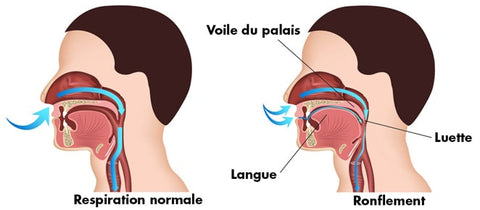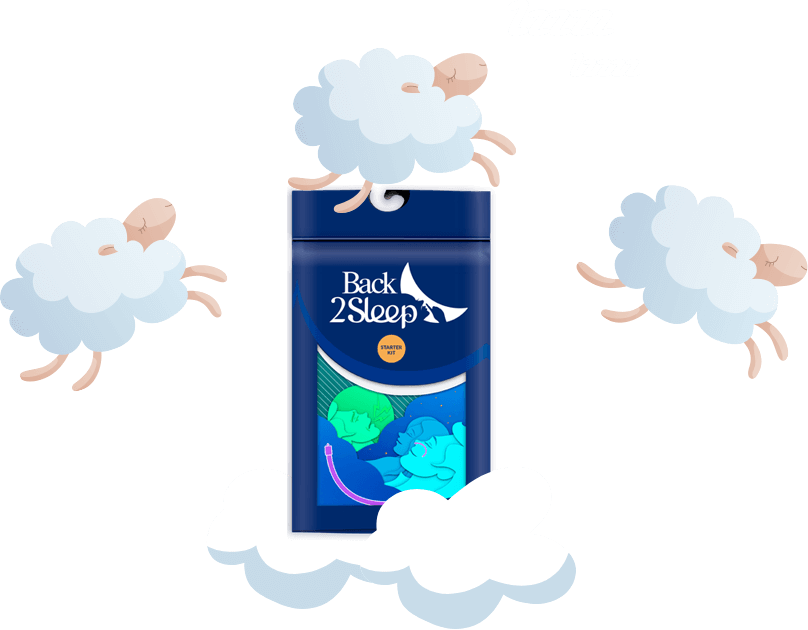Have you ever been bothered by snoring, either your own or that of a loved one?
An anti-snoring machine could be the solution.
Working mainly by keeping the airway open or adjusting your jaw position during sleep, these devices aim to reduce or eliminate snoring.
Choosing the right device is important! It must be comfortable, adapted to the cause of your snoring and economically viable.
What is snoring and why should we pay attention to it?
Why snoring shouldn't be ignored?
Ignoring snoring can be tempting, but it's a bad idea. Why?
Because snoring can be a warning sign of more serious health problems , such as sleep apnea.
This condition, where breathing stops and resumes during sleep, can have serious consequences, such as:
💊 increased risk of hypertension,
💊 heart disease,
💊 diabetes.
What are the common causes of snoring?
Several factors can contribute to snoring, such as:
💊 overweight,
💊 age,
💊 alcohol consumption before bedtime,
💊 allergies,
💊 anatomical problems such as a long soft palate or deviated nasal septum
Identifying the cause is important(consult a physician or sleep specialist) in order to choose the most appropriate treatment, whether it be lifestyle changes, anti-snoring devices or a sleep aid anti-snoring devices or medical consultation.
What are the health impacts of snoring
Snoring not only affects the quality of your sleep, but it can also have an impact on your overall health.
Disturbed sleep can:
💊 cause daytime drowsiness,
💊 reduce your concentration,
💊 increase the risk of accidents,
💊 affect your mood.
In the long term, sleep disturbances can contribute to metabolic and cardiovascular disorders.

What are the different types of snoring and what do they mean?
Nasal snoring and its implications
When the nasal passages are blocked, for example by allergies or a cold, nasal snoring can occur.
This type of snoring is often less worrying but may indicate nasal congestion or a deviated septum.
Simple solutions such as nasal strips or a humidifier can help reduce this type of snoring.
Mouth snoring: signs and solutions
Mouth snoring occurs when you breathe through your mouth during sleep, often due to nasal obstruction or the habit of sleeping with your mouth open.
This can dry out the throat and aggravate snoring.
Devices such as dental orthoses or oral retractors can be effective solutions.
Snoring due to sleep apnea
Perhaps the most serious, this type of snoring is often noisy and irregular, followed by pauses in breathing.
This is a characteristic sign of obstructive sleep apnea, a condition that requires medical attention, as it is linked to a variety of health problems.
The CPAP devices or intranasal orthoses are common treatments for this type of snoring.
Positional snoring and its impact
Snoring can be accentuated by certain sleeping sleeping positions especially on the back, where gravity favors narrowing of the airways.
Changing your sleeping position or using an anti-snoring pillow can help reduce this type of snoring.
What criteria should you consider when choosing the best anti-snoring machine?
Evaluating efficacy: clinical studies and medical validation
When choosing an anti-snoring machine, it's important to check whether the product has been evaluated through clinical studies or has received validation from healthcare professionals.
Look for products with verifiable testimonials or medical certifications, which can guarantee their effectiveness in reducing snoring and improving sleep quality.
Comfort and personalization: a priority for treatment adherence
Comfort is a decisive factor in the continued use of the device.
Check if the machine offers customization options or possible adjustments to suit your specific anatomy.
For example, a dental orthosis should be adjustable to fit your jaw, while a nasal device should have different sizes or be made of soft materials to avoid irritation.
Value for money: initial investment vs. long-term costs
Analyze the initial cost of the device in relation to its potential maintenance and replacement costs.
A less expensive device requiring frequent replacement may prove more costly in the long run.
Also consider whether the product is covered by a warranty, or whether additional accessories are required for optimal operation.
User feedback and expert advice: a wealth of information
Carefully read user reviews on various platforms to find out about their actual experience with the product.
The recommendations of experts, such as sleep specialists or dentists, can also point you in the direction of proven, reliable choices.
These notices can help you understand the practical advantages and disadvantages of the device in real-life situations.
Maintenance and hygiene: ease of cleaning and durability
Consider how easy it is to clean the device, an important aspect for avoiding infections and extending the product's life.
Check whether the unit can be easily disassembled for thorough cleaning, or whether it requires special cleaning products.
The durability of materials is also an aspect to consider ensuring that your investment will be beneficial in the long term.

The Back2Sleep solution, the intranasal orthosis
Features of the Back2Sleep intranasal orthosis
The intranasal orthosis by Back2Sleep is distinguished by its design, which adapts to the shape of the nostrils without causing discomfort.
Made from soft, hypoallergenic materials, it minimizes the risk of irritation and is suitable for prolonged use.
Its ease of insertion and removal also contributes to its appeal to users.
Advantages of the Back2Sleep orthosis over other solutions
One of the main advantages of the Back2Sleep orthosis is that it offers a non-invasive alternative to snoring.
Unlike oral appliances or CPAP machines, intranasal orthoses do not involve bulky or uncomfortable devices.
It is particularly suitable for people who find other options too intrusive or uncomfortable for sleep.
Frequently asked questions about anti-snoring machines
Q. How do I know if I need an anti-snoring machine?
- If you wake up tired despite a full night's sleep, if your partner complains about your snoring, or if you often wake up coughing or choking, you may need an anti-snoring machine.
Signs such as:
💊 daytime sleepiness,
💊 morning headaches,
💊 irritability.
They may also indicate that your snoring is interfering with the quality of your sleep.
Are anti-snoring machines comfortable to use all night long?
- Comfort varies depending on the type of anti-snoring machine.
Some devices are designed with soft, adaptive materials to maximize comfort.
It is often advisable to test the device for a short period before using it overnight.
Adaptation can take time, but many machines are designed to offer optimum comfort and efficiency.
h3: How long does it take to see results with an anti-snoring machine?
- Results may vary from one person to another.
Some users notice an improvement from the very first night, while others may need a few weeks to get used to the device and feel its full benefits.
It's important to have realistic expectations and to give your body time to adapt to using the machine.

- Choosing a selection results in a full page refresh.
- Opens in a new window.







